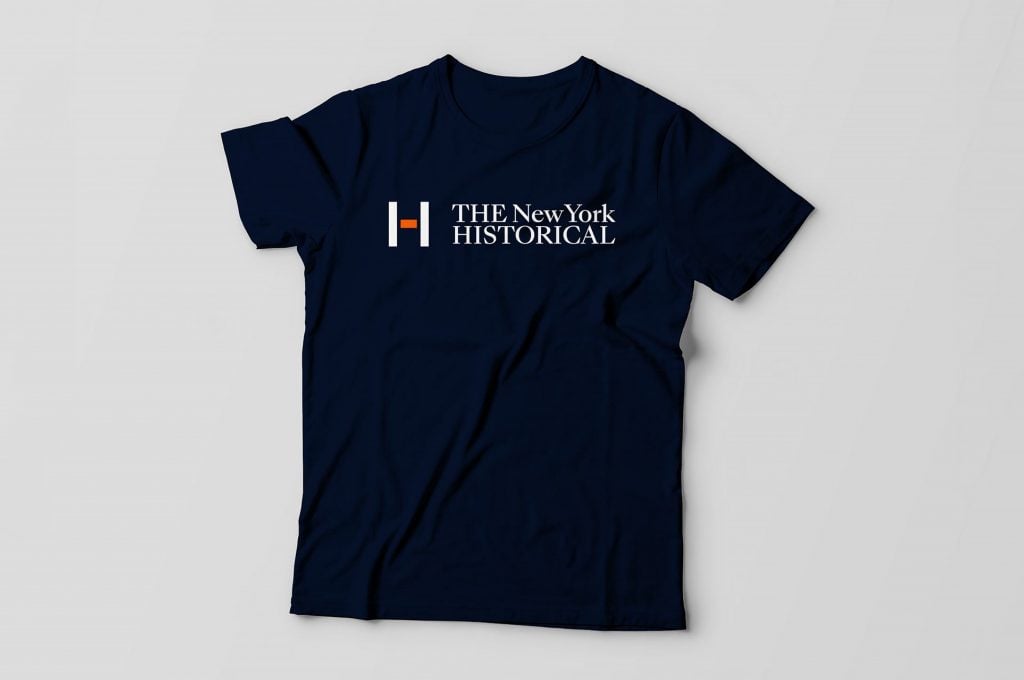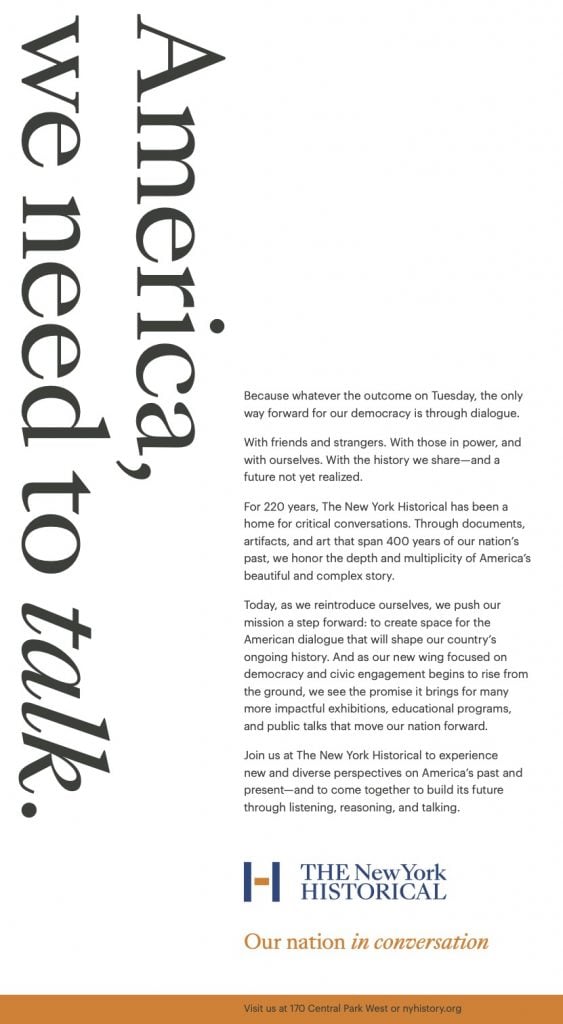
29 Oct A New Wing—and Name—for the New-York Historical Society
Source Credit: Content and images from Artnet News. Read the original article - https://news.artnet.com/art-world/new-york-historical-society-new-wing-name-2560342
The New-York Historical Society has secured a lead donor for its forthcoming new wing dedicated to American democracy—and is simplifying its name to become the New York Historical.
The museum, founded in 1804, announced these big changes as part of its 220th anniversary celebrations, the day before it was set to host a naturalization ceremony for 75 new citizens.
The $175 million construction project, which broke ground in 2021 and officially started construction a year ago, will be completed thanks to a major gift from H.M. Agnes Hsu-Tang and Oscar L. Tang. Officially dubbed the Tang Wing for American Democracy, it will open in 2026, just in time for the 250th anniversary of the signing of the Declaration of Independence and the founding of the United States of America.
“We’ll be adding significant exhibition space,” museum president and CEO Louise Mirrer told me. “Education has really become the cornerstone of everything that we do. We’ve got up to 300,000 students who learn history and civics with us every year, so we’ll be adding classroom space. And the top floor of the new wing will be dedicated to telling the story of the LGBTQ+ community history in the United States in collaboration with a new museum.”

A rendering of the planned roof garden at the New York Historical. Courtesy of SKOLNICK Architecture and Design Partnership (SKOLNICK).
The new wing will become the first home for the American LGBTQ+ Museum, founded in 2017. The museum-within-a-museum on the top floor, the city’s first institution dedicated to LGBTQ+ achievements and the community’s struggles for civil rights, will feature two galleries and a rooftop garden terrace.
The 80,000-square-foot expansion, designed by architect Robert A.M. Stern, is being built on an empty lot the museum has owned since 1937. The new facade will feature the same Deer Isle, Maine, granite used to build the current museum building 120 years ago.
The project is funded with $75 million in city, state, and federal support as well as $100 million in private philanthropy, including the Tangs’ donation. The museum is now looking to raise an additional $10 million to fund the wing’s exhibitions and programming.
But the institution will conduct the fundraising campaign under a new name it hopes will have a more inclusive feel for audiences—evoking the sense that everyone is welcome, not just those in proper “society.”

A t-shirt with the new logo for the rebranded New York Historical. Photo courtesy of Lippincott.
“When we were founded in 1804, we were a member institution, and they were pretty careful about who could be a member and who couldn’t,” Mirrer said.
As the museum began to think about rebranding—an effort with creative consultancy Lippincott—Mirrer “realized we didn’t want society to mean what it had meant traditionally.”
Perhaps even more consequential is the loss of the museum’s signature hyphen between “New” and “York”—a relic of the city’s past dating to the institution’s 1804 founding. Back then, the city’s name was officially “New-York,” but the convention of using the hyphen (also once seen in New Hampshire and New Jersey) gradually fell out of practice in the mid 1800s.
The museum stubbornly clung to the hyphen for decades, even when a city official passed a motion banning the hyphenation of New York in 1945. He called the hyphen “a gremlin which sneaks around in the dark,” according to a contemporaneous report from the New York World-Telegram.

A rendering of the planned Klingenstein Family Gallery at the New York Historical. Courtesy of SKOLNICK Architecture and Design Partnership (SKOLNICK).
A name change, curator Donald A. Shelley declared at the time, was impossible, because “it’s chiseled in stone on the front of our building.”
A 2013 museum blog post detailing this history noted that the institution was “proud of the hyphen in its name” and had even named its staff softball team the Hyphens. (The name was so distinctive it even inspired a section of Hyphen, a 2021 book about the punctuation mark by Pardis Mahdavi.)
But nothing is set in stone—even if it literally is. Now, the museum is ushering in a new chapter in its history by abandoning the antiquated grammatical convention.
“It seems like a radical break, obviously for some people, but honestly there’s a long history of that hyphen being contested territory,” Mirrer said.
It’s also adopting a new logo, combining orange for New York’s Dutch roots, white for the Navajo people, and blue as a presidential color. It recalls the the letter “H,” but with a gap between the sides and center that makes it look quite a bit like a hyphen. It’s a subtle nod to that legacy, but also represents New York’s longstanding ability to act as a bridge between different people and cultures.
The museum’s new tag line, “Our nation in conversation,” replaces “Because history matters.”

The New York Historical is running this ad to promote its rebrand. Courtesy of the New York Historical.
“We want to stress that especially in this time when people tend to be so polarized, there are places where you can still have a conversation,” Mirrer said. “Our collections are national collections. They’re American history collections, in the context of the globe, through the prism of New York. And it’s American history in all of its many, many aspects.”
The new wing will allow the museum to grow its Academy for American Democracy, an educational initiative for sixth graders about voter engagement and American history, from 3,000 to 30,000 students a year.
It will also be home to the Dorothy Tapper Goldman Center for Teaching Democracy, which brings together teachers, scholars, and museum professionals to engage with history, political theory, and pedagogy, and the institution’s museum studies masters program, which started in 2019 and is part of the CUNY School of Professional Studies. (Hsu-Tang funds a scholarship program for students in financial need.)

A rendering of the planned conservation studio at the New York Historical. Courtesy of SKOLNICK Architecture and Design Partnership (SKOLNICK).
The museum will also be able to bring some of its offsite collections back to the main building in an expansion of the Patricia D. Klingenstein Library, which owns some 10 million objects. And there will be a conservation studio for painting and paper with natural light, advanced ventilation, and plenty of workspace.
“We have materials going back to the 16th century, before the 13 colonies existed,” Mirrer said. “We have materials that are priceless. The authorization to purchase Louisiana, with the little red wine stain in the right-hand corner. To care for a collection like ours, we really need state-of-the-art conservation, so this is a quantum leap forward.”
Some of the artifacts going on view in the new galleries are expected to relate to New York’s historical role as the seat of American democracy, having served as the nation’s first capitol and the site of George Washington’s inauguration. The collection includes the Bible used in the ceremony and the armchair Washington sat in afterward in the Senate chamber of Federal Hall.
Source Credit: Content and images from Artnet News. Read the original article - https://news.artnet.com/art-world/new-york-historical-society-new-wing-name-2560342

